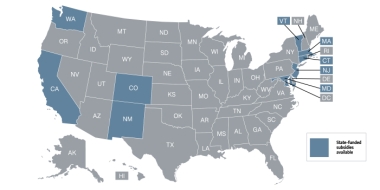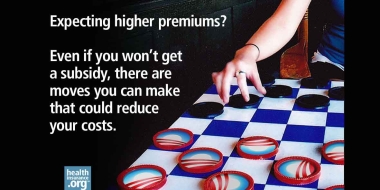Q. How might my tax deductions affect the size of my ACA premium subsidy?
Obamacare subsidy calculator *
Estimated annual subsidy
$0
A: Your best bet is to talk with a licensed certified public accountant (CPA) who specializes in tax preparation. If you find a CPA who is trained on the ins and outs of tax preparation, that person might be able to help you spot places where you might be missing out on deductions and tax breaks that would lower your income for ACA purposes, which could result in larger premium subsidies.
That said, there are some basics to keep in mind. And we can start with the fact that the rules are a lot different from 2021 through 2025, as a result of the American Rescue Plan (ARP) and the Inflation Reduction Act. The ARP, aimed at helping Americans recover from the COVID pandemic, made premium subsidies larger and eliminated the “subsidy cliff” for Marketplace enrollees with household incomes above 400% of the federal poverty level (FPL) in 2021 and 2022, and the Inflation Reduction Act extends those provisions through 2025. (The “subsidy cliff” refers to the fact that under Affordable Care Act (ACA) rules, premium subsidies end abruptly if a household’s income goes above 400% of the FPL, regardless of the price of their coverage. This will once again be the case starting in 2026, unless the ARP rules are extended again.)
So, under ARP, subsidies are available to people with ACA-specific modified adjusted gross income above 400% of the FPL (the income cap for subsidy eligibility in prior years) if they would otherwise have to spend more than 8.5% of their income to purchase the benchmark plan (second-lowest-cost Silver plan).
As a result, subsidies now extend well above that income level depending on the circumstances. Older people and people in areas where health insurance is more expensive can have incomes well above 400% of the FPL and still qualify for a subsidy, whereas younger people and people in areas where coverage is less expensive may still find that they don’t qualify for a subsidy even with an income a little above 400% of the FPL. (To clarify “older” and “younger” it’s important to keep in mind that health insurance premiums adjust upward as people get older, under a 3:1 ratio set by the ACA.1 In most states,2 a person 64 or older will be paying exactly three times as much as a person who is 21, before subsidies are applied. But the age rating variations follow a curve rather than a straight line, so age-related premium growth gets sharper as people get older.)
The open enrollment period for ACA-compliant individual/family health insurance (on-exchange or off-exchange) runs from November 1 to January 15 in most states (some state-run exchanges have different deadlines). The enrollment window applies both on-exchange and off-exchange, but premium subsidies are only available on the exchange. So, if you’re subsidy-eligible (and most exchange enrollees are), you’ll want to make sure you sign up for coverage through the exchange during the open enrollment period.
Although the ARP and Inflation Reduction Act have made subsidies larger (as explained later in the article) and more widely available, the specifics of how household income is calculated under the ACA remain the same. Here’s how it works:
ACA premium subsidies are based on modified adjusted gross income (MAGI), but the calculation for it is specific to the ACA (and different from other definitions of MAGI, such as the one used to determine Medicare income-related monthly adjustment amounts3 and the one used to determine how much your tax-deductible traditional IRA contribution can be if you’re covered by a retirement plan at work4) . For the most part (unless your income is very low, which is discussed at the end of this article), a lower MAGI will result in a larger premium subsidy. (A lower MAGI results in a larger premium subsidy, unless your income is low enough that it makes you eligible for Medicaid or puts you in the coverage gap in states that haven’t expanded Medicaid.)
For many people, ACA-specific MAGI is the same as adjusted gross income, or AGI (from Form 1040, line 11). But if you have any tax-exempt Social Security income, tax-exempt interest income, or untaxed foreign income, you have to add those amounts to your AGI to get your ACA-specific MAGI.5
How contributing to a retirement plan, HSA contributions, and self-employed health insurance premiums reduces MAGI
A lower income and more adjustments to income will reduce MAGI. You should consult your tax advisor to consider the available deductions/adjustments on your tax return that are above the line that shows your AGI (this is on Line 11, and the deductions/adjustments are calculated on Schedule 1 and then transferred to the 1040 on Line 10), since reductions to your AGI will also reduce your ACA-specific MAGI.6
Tax-deductible contributions to a traditional individual retirement account (IRA) will reduce your ACA-specific MAGI.7 Your tax advisor should be able to explain the details of this to you, including how to determine whether you’re eligible to make tax-deductible contributions to a traditional IRA.
In addition, your tax advisor can explain how contributing to an employer-sponsored pre-tax retirement plan like a 401(k) will lower your ACA-specific MAGI. (Note that if your employer offers health benefits, it’s unlikely that you’ll qualify for a Marketplace subsidy. Here’s more about that.)
If you’re self-employed, your tax advisor can advise whether it is in your best interest to set up a self-employed retirement plan such as a SEP IRA, SIMPLE IRA, or Solo 401(k). Talk with your tax advisor to see if one makes sense for you. Keep in mind that these retirement plans for self-employed people have contribution limits that are potentially higher than those of traditional IRAs allowing people to reduce their MAGI by a larger amount than a traditional IRA would allow.
If you have an HSA-eligible high-deductible health plan (HDHP), contributions to an HSA will reduce your ACA-specific MAGI. Your tax advisor should be able to answer any questions you have about this.
Self-employed people may also deduct their health insurance premiums, which may lower their MAGI, but it gets a bit complicated if that’s the factor that makes you eligible for a premium subsidy.
Your subsidies might go a long way toward covering the contributions you make to your IRA and HSA
To put all of this in perspective, consider a married couple, each 55 years old, with an HSA-eligible health plan and a combined household income of $90,000. With the American Rescue Plan rules in place, this couple is eligible for a premium subsidy even though their income is well above 400% of the FPL. But we’ll use this example to illustrate how their subsidy will increase if they make various pre-tax contributions.
Assuming they have earned income (meaning their income isn’t all from investments and capital gains), they can each contribute up to $8,000 to an IRA for 2024 ($7,000 plus a $1,000 catch-up contribution, since they’re over age 50)8 and they can contribute up to $10,300 to their HSAs, assuming they both have coverage under an HDHP and maintain separate HSAs so that they can each take advantage of the catch-up contribution allowance. Contributing the maximum amounts would bring their 2024 MAGI down to $63,700.
Let’s say this couple lives in Chicago, Illinois (zip 60647). In 2024, with the American Rescue Plan’s subsidy enhancements in effect, they qualify for a monthly subsidy of $754 if their MAGI is $90,000. But if their income is $63,700, they qualify for a subsidy of $1,043 per month (to make contributions to an HSA, they’ll need to buy an HSA-qualified plan, the cheapest of which is about $216/month in premiums after the subsidy is applied).9
That’s an extra $289 per month in subsidies, amounting to $3,468 for the year, just because they opted to make the maximum contributions to their IRAs and HSA.
Before the ARP, this couple would not have qualified for any subsidy at all with an income of $90,000, but would have qualified for a substantial subsidy with an income of $63,700 (not quite as large as it is under the ARP, but still very significant).
Younger applicants get smaller subsidies, but the general concept remains the same: Contributing to a retirement account and/or HSA will result in lower health insurance premiums, as long as your MAGI stays above the lower threshold for subsidy eligibility: At least 100% of the FPL in states that haven’t expanded Medicaid, and above 138% of the FPL in states that have expanded Medicaid.
All calculations above are based on results from the HealthCare.gov plan comparison tool.
You have until April to make the prior year’s HSA or IRA contributions
Another thing to keep in mind about HSA and IRA contributions: You can deposit money in those accounts at any time during the year or even in the first few months of the next year, as long as you make your contributions before the tax filing deadline.10
So you’ll have until April 15, 2025 to make your 2024 contributions to an IRA and/or an HSA (assuming you have an HSA-qualified health plan) and reduce your MAGI for 2024. (See Question 4 here, for an example of this.) Premium subsidies are reconciled on your tax return, so that’s when you’d be sorting out the details with the IRS in terms of the exact amount of premium subsidy you were supposed to receive during the year.
Other deductions and their impact on MAGI
There are other deductions/adjustments that will reduce your MAGI, since they reduce your AGI11 and don’t have to be added back to calculate the ACA-specific MAGI. These include things like alimony payments (from settlements executed before 2019; alimony from a settlement executed in 2019 or later is not counted), student loan interest, tuition and fees, educator expenses (up to the allowable cap, currently set at $300), moving expenses, and the deductible portion of self-employment taxes.11 The deductions that reduce AGI are found on lines 11 through 24 of Schedule 1 for Form 1040.
Itemized deductions like mortgage interest, charitable contributions, medical expenses, etc. (or the standard deduction instead) are subtracted after AGI is calculated. So they do not lower AGI and thus do not have an impact on MAGI.12
How an increase in MAGI may result in eligibility for subsidies
On the other end of the spectrum, for people living in states that have not expanded Medicaid, Medicaid is available on a very limited basis, and premium subsidies in the exchanges are not available to households with incomes below 100% of the FPL.
If your income is very low and the marketplace is showing that you’re not eligible for Medicaid or any financial assistance with your coverage, you’re probably in the coverage gap. This article is a good summary of how you might be able to handle the coverage gap.
Your MAGI needs to be at least the poverty level to avoid the coverage gap and qualify for subsidies. So depending on your income, you might decide to not take the deductions described above that serve to lower MAGI. But again, you’ll want to speak with a tax professional to make sure you understand the best approach for your specific circumstances.
Louise Norris is an individual health insurance broker who has been writing about health insurance and health reform since 2006. She has written dozens of opinions and educational pieces about the Affordable Care Act for healthinsurance.org.
Footnotes
- “Market Rating Reforms” and “State Specific Age Curve Variations” Centers for Medicare & Medicaid Services. Accessed March 15, 2024. ⤶
- “State Specific Age Curve Variations” Centers for Medicare & Medicaid Services. Accessed March 15, 2024. ⤶
- “HI 01101.010 Modified Adjusted Gross Income (MAGI)” Social Security Administration. Accessed March 15, 2024. ⤶
- “What Is the Difference Between AGI and MAGI on Your Taxes?” TurboTax. Feb. 28, 2024. ⤶
- “Modified Adjusted Gross Income” HealthCare.gov Glossary. Accessed Feb. 29, 2024 ⤶
- “Count income & household size” HealthCare.gov. Accessed March 18, 2024 ⤶
- “2023 IRA Deduction Limits – Effect of Modified AGI on Deduction if You Are Covered by a Retirement Plan at Work” IRS.gov. Access March 18, 2024 ⤶
- “401(k) limit increases to $23,000 for 2024, IRA limit rises to $7,000.” Internal Revenue Service. Nov. 1, 2023 ⤶
- “See plans and prices” HealthCare.gov. Accessed Feb. 29, 2024 ⤶
- “Traditional and Roth IRAs” and “Publication 969 (2023), Health Savings Accounts and Other Tax-Favored Health Plans” Internal Revenue Service. Accessed March 15, 2024. ⤶
- “Schedule 1, Additional Income and Adjustments to Income” Internal Revenue Service. Accessed March 15, 2024. ⤶ ⤶
- “Reporting income deductions” HealthCare.gov. Accessed March 18, 2024 ⤶













